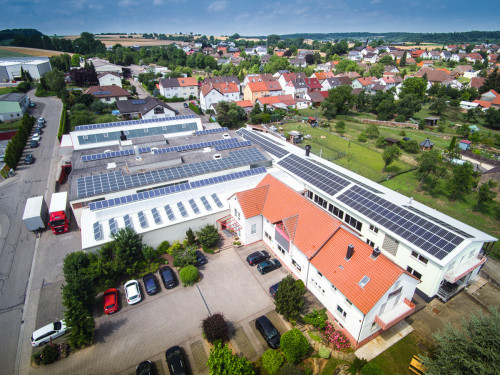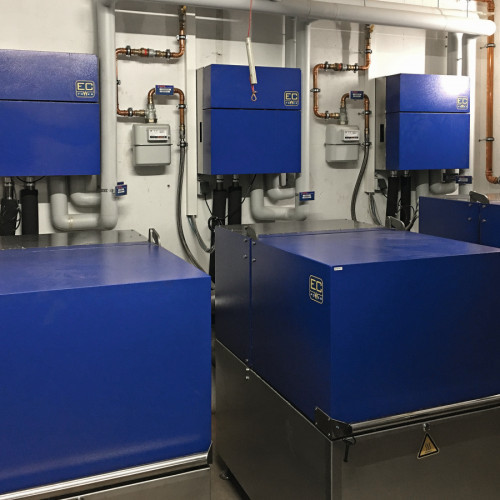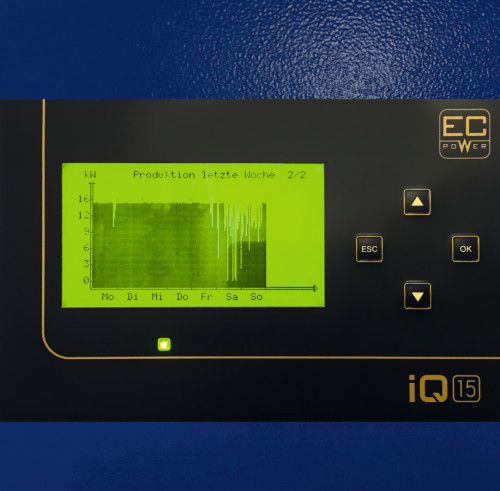With photovoltaic (PV) systems, a distinction is made between feed-in and self-consumption. At the Strähle and MVB Metallveredlung electroplating plants, however, only self-consumption counts today, as it is now hardly worth feeding the electricity into the grid. The advantage of self-consumption: reduced electricity costs. Storage solutions are also already available.
The companies Strähle and MVB Metallveredelung have been fully active on the spot electricity market since 2020. This means that the average daily price that electricity customers can obtain from the Federal Network Agency one day in advance is calculated. At www.smard.de it is very easy to see where and from which generation source the electricity is obtained.
PV systems at a glance
Strähle Galvanik in Zaisenhausen has been generating photovoltaic (PV) electricity for a very long time. The first system for full feed-in was installed in 2005, at that time for 0.53 cents per kWh for 20 years. A year later, it became clear that a second system would have to be installed before the feed-in tariff fell.
 PV modules on the roof of Strähle Galvanik, installation of which began back in 2005. Today, 150 KWp of power is available
PV modules on the roof of Strähle Galvanik, installation of which began back in 2005. Today, 150 KWp of power is available
There are two advantages: High feed-in tariffs and a reduction in peak load. A total of 150 KWp (kilowatt peak = maximum output that a PV system can generate) is available via photovoltaic systems: 75 KWp for full feed-in by 2025 and 75 KWp for self-consumption. The calculation for self-consumption is simple: with net electricity costs of 13 cents (price cap) compared to a feed-in tariff of 6 cents, it makes no sense to feed more into the grid. Especially as the electricity saving is not the net price but the gross electricity price. The economic benefit of the savings is therefore reduced by additional costs.
Due to the high electricity prices in 2021 and 2022, the MVB Bretten electroplating plant also invested in a 154 KWp PV system. As a result, the high electricity prices could already be compensated for in 2022 and 2023. A self-sufficiency rate of 22% and a direct consumption rate of 83% will be achieved in 2023. 17 % was or had to be fed into the electricity grid at weekends.
Advantages and disadvantages of electricity storage systems
There are now quite inexpensive industrial electricity storage systems on the market. They are available for around 1000 euros per kilowatt. It can certainly make sense to install a storage system. However, it should be borne in mind that an electricity storage system never returns the full power. In other words, if I have a 50 KW storage unit, I can only retrieve a maximum of 40 KW quickly. We are also talking about a current efficiency of around 90 %.
There are now quite inexpensive industrial electricity storage systems on the market.
In order to absorb power peaks of 10 KW per 15 minutes, I need a storage system of 150 KW for a peak of 250 KW. Or I need to be able to call up 9 KW per minute at a 500 KW load. In the worst case, a 10 KW power peak would cost 1800 euros on the electricity market. A 150 KWh storage system has a purchase price of 150,000 euros. For a residential house, storage systems of between 5 and 15 KWh are assumed, depending on what is operated with them.
An important question, for which the practical experience gained with storage systems to date is not yet sufficient, is how long a storage system can withstand rapid charging and discharging. Experts are talking about ten years, after which the batteries should be exhausted.
Using CHP units correctly
Many manufacturers, operators or so-called contracting companies naturally want to sell the largest possible systems. However, it makes sense to first look at your base load, the amount of heat you need and whether you can purchase heat. A combined heat and power plant (CHP) can be a money saver if it is designed correctly. If not, the costs quickly go into the red. Gas consumption and maintenance costs should not be underestimated.
We differentiate between heat-led and electricity-led CHP units; at Strähle, both variants are used:
Three small CHP units connected in cascade, which primarily generate the heat that is required. A large 50 KW CHP unit, which is electricity-led and buffers the heat in large buffer storage tanks when electricity consumption is high. In winter, there is also a peak load boiler with a modulating burner that produces additional heat when it is needed. The great advantage of a properly designed CHP unit is that it can generate electricity 24 hours a day when the heat is needed. We know of some CHP units that were completely oversized because the operators thought they had to generate the electricity that was consumed during operation. As described above, this only works if the heat can be used or sold to the neighbor (see also the electricity saving series part 3 from Galvanotechnik 10/2023 from p. 1305).
You can roughly calculate that 50 KW of electrical energy generates 150 KW of thermal energy and 500 KW of electrical energy thus replaces four large gas boilers. So there is no reason to continue buying expensive gas.
Official hurdles
As usual, our friends from the authorities put obstacles in our way. This is because users have not done the math with the Federal Network Agency, let alone with the network operator. Another disadvantage is that for PV systems over 100 KWp - as in the case of Strähle and MVB Bretten - users have to take over the marketing themselves. Up to 100 KWp, the grid operator takes care of the power purchase; if the output of the PV system is higher, the user is obliged to look for a distributor who will purchase the excess power at the weekend, unless he has a correspondingly large storage system that stores the excess power. And beware: the size of the electricity storage system is also taken into account. It is important to specify the size of the storage system when applying for a permit, otherwise the storage system will no longer be approved with this size.
Anyone applying for a permit for a PV system should obtain information from the authorities before investing. There are known examples of a 500 KWp system not being approved because state and federal laws were in conflict with each other.
And if you have to organize the purchase of electricity yourself, you will find that the choice of electricity buyers is limited. Customers like to be companies that belong to the grid provider - and pay 3-4 cents per kWh net for the electricity that will later cost private households 38 cents gross (net here is the pure electricity price. Gross is the electricity price with taxes and levies plus electricity and VAT).
Speaking of which: the know-how presented here is a good basis for entering into energy-efficient production. This pays off, but is also associated with high investments - at least 3 million euros are required for plant technology and energy management. Nevertheless, the sooner you get started, the sooner the investment will pay for itself!
Photos: Strähle Galvanik / MVB Metallveredlung




